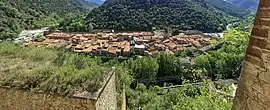Villefranche-de-Conflent
Vilafranca de Conflent | |
|---|---|
 A view of Villefranche | |
.svg.png.webp) Coat of arms | |
Location of Villefranche-de-Conflent | |
 Villefranche-de-Conflent  Villefranche-de-Conflent | |
| Coordinates: 42°35′13″N 2°22′01″E / 42.586825°N 2.366815°E | |
| Country | France |
| Region | Occitania |
| Department | Pyrénées-Orientales |
| Arrondissement | Prades |
| Canton | Les Pyrénées catalanes |
| Government | |
| • Mayor (2020–2026) | Patrick Lecroq[1] |
| Area 1 | 4.46 km2 (1.72 sq mi) |
| Population | 207 |
| • Density | 46/km2 (120/sq mi) |
| Time zone | UTC+01:00 (CET) |
| • Summer (DST) | UTC+02:00 (CEST) |
| INSEE/Postal code | 66223 /66500 |
| Elevation | 390–1,395 m (1,280–4,577 ft) (avg. 432 m or 1,417 ft) |
| 1 French Land Register data, which excludes lakes, ponds, glaciers > 1 km2 (0.386 sq mi or 247 acres) and river estuaries. | |
Villefranche-de-Conflent (French pronunciation: [vilfʁɑ̃ʃ də kɔ̃flɑ̃] ⓘ; Catalan: Vilafranca de Conflent) is historically a town in the Conflent region of Catalonia, and now a commune in the Pyrénées-Orientales department in southern France.[3]
Geography
Villefranche-de-Conflent is located in the canton of Les Pyrénées catalanes and in the arrondissement of Prades.[3]

The town's confined site, at about 440 m above sea level, is relatively level ground surrounded by
- the northeast-flowing river Têt (on the town's west and north),
- the Cady, which flows north to empty into the Têt (on the east), and
- a peak (at nearly 800 m), less than 800 m away (on the south).
Transport
- Roads
The N116 from Perpignan on the Mediterranean passes, as a two-lane highway, between the southern town wall and an embankment cut into the high ground to the south; this route continues west into the adjacent Cerdagne region.
- Train
The town's train station starts and ends the route of the scenic Yellow train.
History
The town's access to the French Cerdagne makes it an important strategic location. It was already occupied by Celtic tribes, and then by Romans, Visigoths, Muslim Moors, and then the Spanish. Fortifications around the town were built by the counts of Conflent at the end of the 9th century;[4] in 1374, Villefranche resisted the siege of Jaume III the son of last king of Majorca. In the mid-1400s, when it was a Spanish possession, parts were adapted to allow for firearms.[4] In July 1654, the French captured the city after eight days, and the troops of Louis XIV took Puigcerda from the Spaniards. When the territory was ceded to the French after the Treaty of the Pyrenees (1659), the town became an important French defense against possible Spanish incursions. The town was part of the program of construction and improvement of outlying French defenses, which included building the Fort Libéria on a hill above the village by Sébastien Le Prestre de Vauban, the military engineer of Louis XIV,[4] and as such was listed as a World Heritage Site in 2008.[5]
The defensive walls of the town remain.
Population
| Year | Pop. | ±% p.a. |
|---|---|---|
| 1968 | 507 | — |
| 1975 | 435 | −2.16% |
| 1982 | 294 | −5.44% |
| 1990 | 261 | −1.48% |
| 1999 | 225 | −1.64% |
| 2007 | 235 | +0.55% |
| 2012 | 229 | −0.52% |
| 2017 | 213 | −1.44% |
| Source: INSEE[6] | ||
See also
Notes
- ↑ "Répertoire national des élus: les maires" (in French). data.gouv.fr, Plateforme ouverte des données publiques françaises. 13 September 2022.
- ↑ "Populations légales 2021". The National Institute of Statistics and Economic Studies. 28 December 2023.
- 1 2 INSEE commune file
- 1 2 3 Lepage, Jean-Denis G.G. (2009). Vauban and the French Military Under Louis XIV: An Illustrated History of Fortifications and Strategies. McFarland. pp. 223–25. ISBN 9780786456987.
- ↑ "Fortifications of Vauban". UNESCO World Heritage Centre. United Nations Educational, Scientific, and Cultural Organization. Retrieved 14 November 2021.
- ↑ Population en historique depuis 1968, INSEE
References
- Ayats, Alain, "Les fortifications de Vauban", Trabucaire, 2005, ISBN 2-84974-026-8
External links
